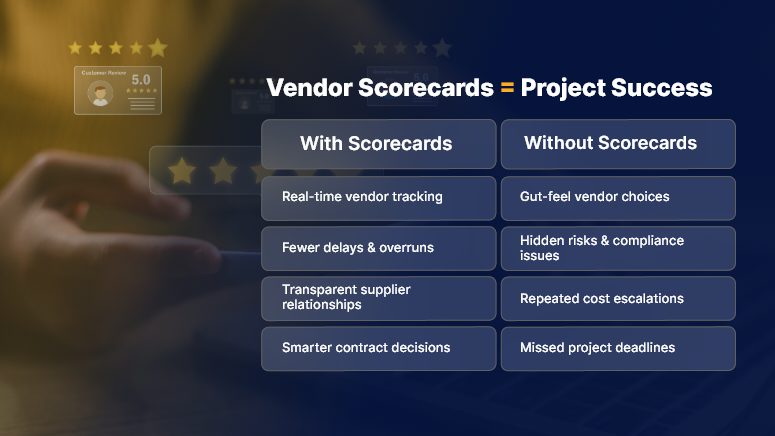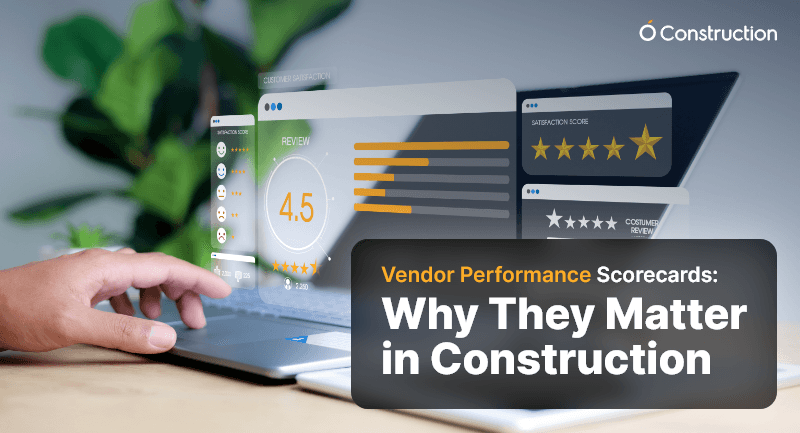Did you know that nearly 70% of construction projects face cost overruns or delays due to vendor-related issues? That’s a staggering number — and one that reveals a hidden truth: no matter how strong your project plan is, your vendors can make or break your success.
This is where vendor performance scorecards step in. They aren’t just spreadsheets; they’re powerful tools to measure, monitor, and improve how your vendors deliver on promises. By tracking key metrics like cost, quality, and timeliness, construction firms can ensure accountability, reduce risks, and make smarter decisions.
In this blog, we’ll explore why vendor performance scorecards matter in construction, how they can transform vendor management, and practical strategies to implement them effectively with a digital platform like OConstruction.

Business Relevance & Why It Matters
In construction, your vendors are your lifeline. From equipment suppliers to subcontractors, each plays a vital role in meeting deadlines and keeping projects within budget. But here’s the problem: many companies still rely on gut feeling or fragmented spreadsheets to evaluate vendors.
This approach creates three major risks:
- Hidden inefficiencies — poor-performing vendors get repeat contracts because there’s no structured data.
- Inconsistent quality — projects suffer when vendors don’t meet compliance or safety standards.
- Wasted money — delayed deliveries and cost escalations eat into project profits.
By contrast, vendor performance scorecards bring clarity, structure, and accountability. They help you:
- Identify your top-performing vendors.
- Spot and fix recurring problems early.
- Build stronger, data-driven vendor relationships.
Use Cases in Construction:
- A contractor uses scorecards to compare multiple suppliers and choose the most reliable one.
- A project manager leverages scorecards to negotiate better terms with vendors backed by data.
- A finance controller uses vendor scorecards to track compliance and cost efficiency across projects.
The bottom line: vendor performance scorecards aren’t optional anymore — they’re strategic.
Best Practices, Frameworks, and Actionable Strategies
1. Define the Right Metrics
Your scorecard is only as good as the metrics you track. In construction, focus on:
- Timeliness: Were deliveries made on schedule?
- Quality: Did materials meet project standards?
- Cost compliance: Were invoices aligned with contracts?
- Safety compliance: Did vendors follow safety protocols?
- Collaboration: Was communication responsive and transparent?
Each metric should have a clear scoring scale (e.g., 1–5 or percentage-based).
2. Standardize Across Projects
Don’t let each site or manager create their own version. Standardize your scorecards to ensure consistent vendor evaluation across the organization. This reduces bias and makes comparisons fair.
3. Automate Data Collection
Manual scorecards often fail because they rely on subjective opinions or delayed updates. With OConstruction, you can automate:
- Data pulled from invoices (cost accuracy).
- Project timelines (delivery performance).
- Safety reports (compliance tracking).
Automation ensures real-time, objective evaluation.
4. Use Scorecards for Strategic Decisions
Don’t just file away the results. Use them actively to:
- Award contracts to high performers.
- Blacklist unreliable vendors.
- Negotiate better terms with borderline performers.
- Identify training needs for subcontractors.
5. Communicate Results with Vendors
A scorecard should not be a secret file. Share results with vendors to encourage transparency and improvement. Frame it as a partnership tool, not just a policing mechanism.
6. Track Trends Over Time
One scorecard doesn’t tell the whole story. Look at performance over 6–12 months to see if vendors are improving or declining. This helps you decide whether to continue long-term partnerships.
Customer Story Example
BuildMax Construction, a mid-sized contracting company, struggled with repeated delays from multiple suppliers. They adopted OConstruction’s vendor performance scorecards to track timeliness, quality, and cost metrics.
Within just six months, they identified their top three vendors, cut ties with underperformers, and renegotiated terms with others. The result? A 25% reduction in project delays and a 15% increase in cost savings.
By making vendor evaluation data-driven, BuildMax not only improved project delivery but also built stronger relationships with suppliers.
Key Takeaways & Closing Summary
Vendor performance scorecards are not just operational tools; they’re strategic assets in construction management.
Key Insights:
- Vendor scorecards bring accountability, consistency, and transparency.
- They reduce risks of cost overruns and delays.
- Digital platforms like OConstruction make scorecards automated, real-time, and actionable.
In short, when you simplify vendor evaluation, you amplify project success.
Takeaway Thought:
Think of vendor performance scorecards as your project’s early warning system. They highlight strengths, flag risks, and give you the power to make smarter business decisions.
FAQs on Vendor Performance Scorecards in Construction
1. What are vendor performance scorecards in construction?
Vendor performance scorecards are structured evaluation tools that track vendor performance across metrics like cost, quality, timeliness, and compliance. In construction, they help project managers and contractors ensure accountability, reduce risks, and select the most reliable suppliers.
2. Why do vendor performance scorecards matter in construction projects?
They matter because vendor-related issues are one of the leading causes of project delays and cost overruns. Vendor performance scorecards provide data-driven insights that enable construction firms to choose the best vendors, negotiate better contracts, and eliminate inefficiencies.
3. How do you create a vendor performance scorecard?
To create one, define key performance indicators (KPIs) such as timeliness, quality, safety compliance, and cost control. Assign weightages to each metric, design a scoring system, and ensure all project managers use a standardized template. Platforms like OConstruction can automate this process for accuracy and real-time insights.
4. Can vendor performance scorecards improve vendor relationships?
Yes. When shared transparently, scorecards act as a collaborative tool. They show vendors where they’re excelling and where improvement is needed. This fosters accountability and builds long-term, trust-based relationships between contractors and suppliers.
5. What is the role of digital platforms in vendor performance scorecards?
Digital platforms like OConstruction automate scorecard data collection by integrating with invoices, project timelines, and safety reports. This ensures evaluations are objective, consistent, and updated in real time, eliminating manual errors and delays.
6. How often should construction companies evaluate vendors using scorecards?
Best practice is to review vendor performance scorecards after each project milestone or at least quarterly. Regular evaluation ensures issues are spotted early and long-term trends in vendor performance are visible.



